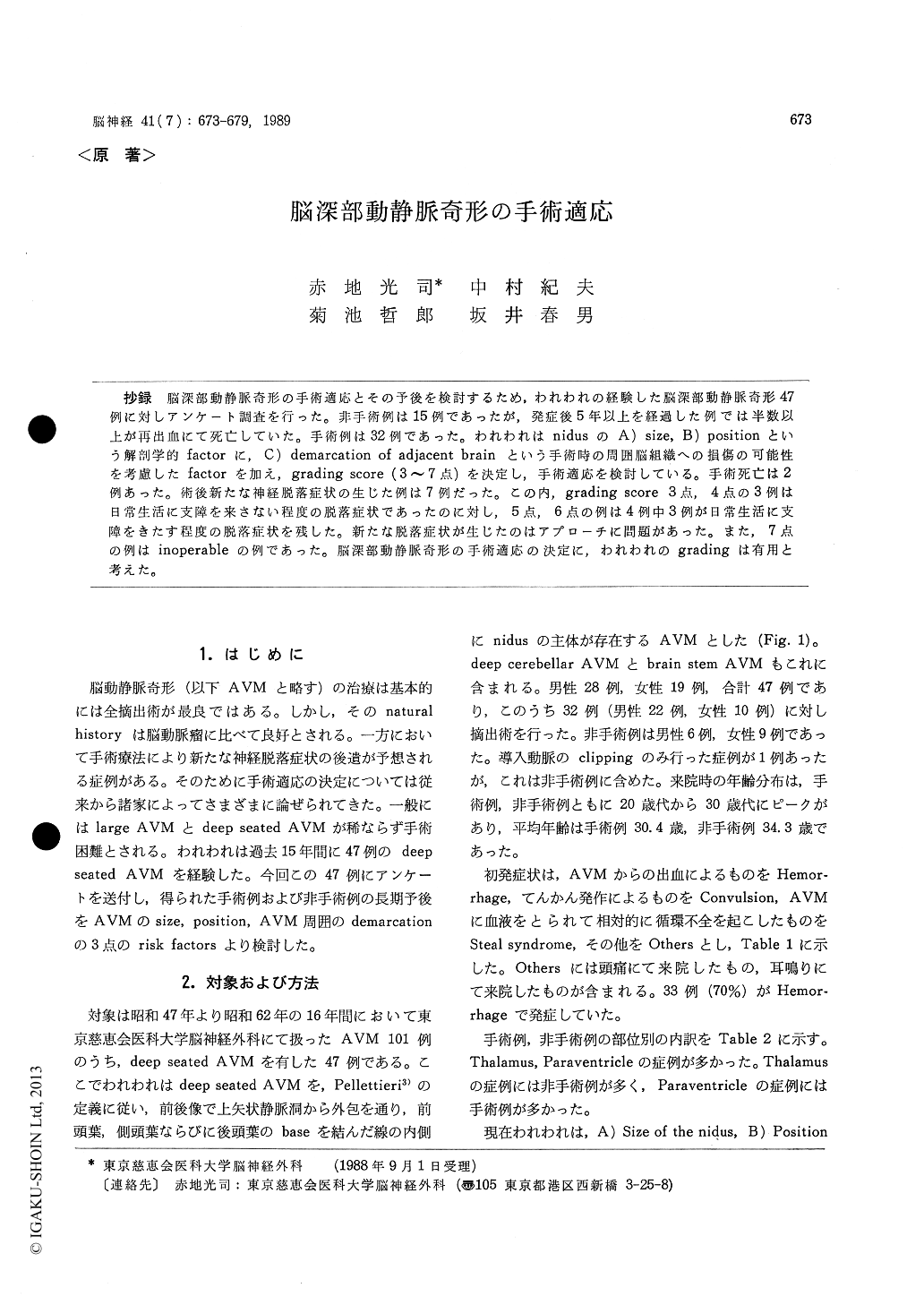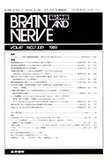Japanese
English
- 有料閲覧
- Abstract 文献概要
- 1ページ目 Look Inside
抄録 脳深部動静脈奇形の手術適応とその予後を検討するため,われわれの経験した脳深部動静脈奇形47例に対しアンケート調査を行った。非手術例は15例であったが,発症後5年以上を経過した例では半数以上が再出血にて死亡していた。手術例は32例であった。われわれはnidusのA) size,B) positionという解剖学的factorに,C) demarcation of adjacent brainという手術時の周囲脳組織への損傷の可能性を考慮したfactorを加え,grading score (3〜7点)を決定し,手術適応を検討している。手術死亡は2例あった。術後新たな神経脱落症状の生じた例は7例だった。この内,grading score 3点,4点の3例は日常生活に支障を来さない程度の脱落症状であったのに対し,5点,6点の例は4例中3例が日常生活に支障をきたす程度の脱落症状を残した。新たな脱落症状が生じたのはアプローチに問題があった。また,7点の例はinoperableの例であった。脳深部動静脈奇形の手術適応の決定に,われわれのgradingは有用と考えた。
The natural history of cerebral arteriovenous malformation (AVN) is still a subject of dispute. In the case of deep seated AVM ruptures, the problem is more serious because the hemorrhages often give rise to severe disability or death, depending on their location. Total extirpation of the nidus is fundamentally the best choice for treatment of AVM. It is never acceptable, however, to allow a persistent post operative deficit.
Forty-seven cases of deep AVM were encounter-ed in the Tokyo Jikei University Hospital. Total extirpation of the nidus was successful in 32 cases, while no surgery was undertaken in 15.
Up to the present time we have taken three risk factors into condition in judging the indications for deep seated AVM surgery : the size of the nidus, the position of the nidus, and the pattern of demar-cation around nidus, as shown on CT scan. When the nidus is bordered by a hemorrhage, cyst, or ventricular wall, dissection of the nidus is facili-tated and injury to adjacent brain tissue is mini-mized, and this is why we included profound demarcation around the nidus as the third factor.
We then determined grade of risk with respect to each factor, and counted a risk score in each case. The long-term result was judged by the re-sponse to questinnaires.
Of the 15 patients who did not undergo surgery, four died on account of rebleeding. The longer the patient having deep AVM survived, the more likely the occurrence of fatal rebleeding.
Of the 32 patients operated on, two died immedi-ately after surgery, while 23 survived in an impro-ved state or without any aggravated neurological deficit. The neurological condition was aggravated after surgery in 7 of 30 surviving patients. In the cases receiving grading score of 3 or 4, the neu-rological condition was aggravated in 3 of 16 cases operated on, but the aggravated conditions were so mild that these cases activities in daily life (ADL) scores were 4 (good). In the cases recei-ving a grading score of 5 or 6, the neurological conditions were aggravated in 4 of 16 cases opera-ted on. The ADL scores for the aggravated cases were 3 (fair) in 3 cases and 4 (good) in 1 case.
The cases with a grading score of 3 or 4, espe-cially the rupture cases, are considered to be suit-able for total extirpation. The operative indica-tions for the cases with grading scores of 5 or 6 will be discussed case by case. The cases with a grading score of 7 were all inoperable.

Copyright © 1989, Igaku-Shoin Ltd. All rights reserved.


